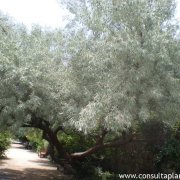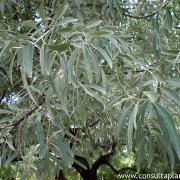Care of the tree Elaeagnus angustifolia or Russian olive |
|
The genus Elaeagnus, family Elaeagnaceae, comprises 100 species of shrubs and trees native to Asia. Some species and hybrids are: Elaeagnus angustifolia, Elaeagnus x ebbingei (hybrid), Elaeagnus x reflexa (hybrid), Elaeagnus pungens, Elaeagnus oxycarpa, Elaeagnus glabra, Elaeagnus commutata. Common names: Persian olive, Russian olive, Silver berry, Oleaster, Wild olive. This species is native to central Asia. They are trees with irregular branches and open bearing that reach 10 meters (32.8 feet) in height. They have thorns on the thin branches; the leaves have the entire edge, are alternate and lanceolate in shape. The color of the foliage is silvery green due to the hairs on the leaves. The yellow flowers are interesting for the aroma they give off; they bloom in summer. The edible fruits look like yellowish-red olives. Russian olive are used in gardens to form groups, as isolated specimens and in public streets and parks. It's ideal for gardens by the sea because it resists salinity. Elaeagnus angustifolia grows in full sun or semi-shade exposures. It resists occasional and light frosts. Persian olive can be grown in any type of soil but prefers cool, light soils. Water moderately all year round, slightly increasing irrigation in summer; it resists drought well. Wild olive does not need pruning or fertilizers. Elaeagnus angustifolia is a are quite resistant plant to pests and diseases that can be attacked by aphids. Silver berry propagates by cuttings in winter or by seeds sown in early spring. |
Images of the tree Elaeagnus angustifolia or Russian olive |
Find plants
Elaeagnus angustifolia or Russian olive | Care and Growing
© 2026 FavThemes


